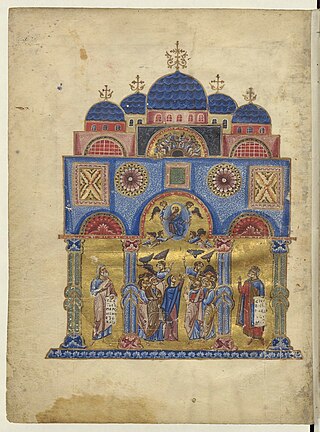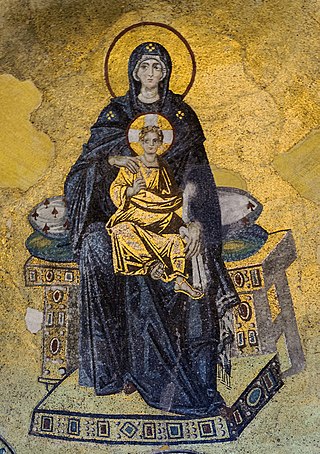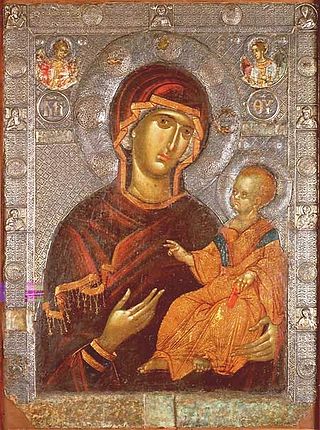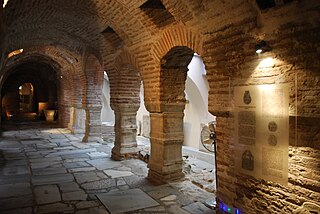Related Research Articles

Anthemius of Tralles was a Byzantine Greek from Tralles who worked as a geometer and architect in Constantinople, the capital of the Byzantine Empire. With Isidore of Miletus, he designed the Hagia Sophia for Justinian I.

Isidore of Miletus was one of the two main Byzantine Greek mathematician, physicist and architects that Emperor Justinian I commissioned to design the cathedral Hagia Sophia in Constantinople from 532 to 537. He was born c. 475 AD. The creation of an important compilation of Archimedes' works has been attributed to him. The spurious Book XV from Euclid's Elements has been partly attributed to Isidore of Miletus.

Hagia Sophia, officially the Hagia Sophia Grand Mosque, is a mosque and former church serving as a major cultural and historical site in Istanbul, Turkey. The last of three church buildings to be successively erected on the site by the Eastern Roman Empire, it was completed in 537 AD. The site was a Chalcedonian church from 360 AD to 1054, an Orthodox church following the Great Schism of 1054, and a Catholic church following the Fourth Crusade. It was reclaimed in 1261 and remained Eastern Orthodox until the fall of Constantinople in 1453. It served as a mosque until 1935, when it became a museum. In 2020, the site once again became a mosque.
The Geoponica or Geoponika is a twenty-book collection of agricultural lore, compiled during the 10th century in Constantinople for the Byzantine emperor Constantine VII Porphyrogenitus. The Greek word Geoponica signifies "agricultural pursuits" in its widest sense. It is the only surviving Byzantine agricultural work.

The Church of the Holy Apostles, also known as the Imperial Polyandrion, was a Byzantine Eastern Orthodox church in Constantinople, capital of the Eastern Roman Empire. The first structure dated to the 4th century, though future emperors would add to and improve upon it. It was second in size and importance only to the Hagia Sophia among the great churches of the capital.

Aydın is a city in and the seat of Aydın Province in Turkey's Aegean Region. The city is located at the heart of the lower valley of Büyük Menderes River at a commanding position for the region extending from the uplands of the valley down to the seacoast. The city forms the urban part of the Efeler district, with a population of 259,027 in 2022. Aydın city is located along a region which was famous for its fertility and productivity since ancient times. Figs remain the province's best-known crop, although other agricultural products are also grown intensively and the city has some light industry.

Macedonian Renaissance is a historiographical term used for the blossoming of Byzantine culture in the 9th–11th centuries, under the eponymous Macedonian dynasty (867–1056), following the upheavals and transformations of the 7th–8th centuries, also known as the "Byzantine Dark Ages". The period is also known as the era of Byzantine encyclopedism, because of the attempts to systematically organize and codify knowledge, exemplified by the works of the scholar-emperor Constantine VII Porphyrogennetos.

Scientific scholarship during the Byzantine Empire played an important role in the transmission of classical knowledge to the Islamic world and to Renaissance Italy, and also in the transmission of Islamic science to Renaissance Italy. Its rich historiographical tradition preserved ancient knowledge upon which splendid art, architecture, literature and technological achievements were built. Byzantines stood behind several technological advancements.
Eutocius of Ascalon was a Greek mathematician who wrote commentaries on several Archimedean treatises and on the Apollonian Conics.

The migration waves of Byzantine Greek scholars and émigrés in the period following the end of the Byzantine Empire in 1453 is considered by many scholars key to the revival of Greek studies that led to the development of the Renaissance humanism and science. These émigrés brought to Western Europe the relatively well-preserved remnants and accumulated knowledge of their own (Greek) civilization, which had mostly not survived the Early Middle Ages in the West. The Encyclopædia Britannica claims: "Many modern scholars also agree that the exodus of Greeks to Italy as a result of this event marked the end of the Middle Ages and the beginning of the Renaissance", although few scholars date the start of the Italian Renaissance this late.

The Palaeologan Renaissance or Palaiologan Renaissance is the final period in the development of Byzantine art. Coinciding with the reign of the Palaiologoi, the last dynasty to rule the Byzantine Empire (1261–1453), it was an attempt to restore Byzantine self-confidence and cultural prestige after the empire had endured a long period of foreign occupation. The legacy of this era is observable both in Greek culture after the empire's fall and in the Italian Renaissance. Scholars of the time utilized several classical texts.
This article lists people, events and other subjects which are referred to as "of Alexandria".

European science in the Middle Ages comprised the study of nature, mathematics and natural philosophy in medieval Europe. Following the fall of the Western Roman Empire and the decline in knowledge of Greek, Christian Western Europe was cut off from an important source of ancient learning. Although a range of Christian clerics and scholars from Isidore and Bede to Jean Buridan and Nicole Oresme maintained the spirit of rational inquiry, Western Europe would see a period of scientific decline during the Early Middle Ages. However, by the time of the High Middle Ages, the region had rallied and was on its way to once more taking the lead in scientific discovery. Scholarship and scientific discoveries of the Late Middle Ages laid the groundwork for the Scientific Revolution of the Early Modern Period.

The city of Thessaloniki in Macedonia, Greece, for several centuries the second-most important city of the Byzantine Empire, played an important role for Christianity during the Middle Ages and was decorated by impressive buildings. Because of Thessaloniki's importance during the early Christian and Byzantine periods, the city contains several Paleochristian monuments that have significantly contributed to the development of Byzantine art and architecture throughout the Byzantine Empire and Serbia. The evolution of Imperial Byzantine architecture and the prosperity of Thessaloniki go hand in hand, especially during the first years of the Empire, when the city continued to flourish. Despite the capture of Thessaloniki by the Ottoman Empire in 1430, the Christian monuments were not destroyed, and travelers such as Paul Lucas and Abdulmejid I document the city's wealth in Christian monuments during the Ottoman control of the city.

Greece played a crucial role in the transmission of classical knowledge to the Islamic world. Its rich historiographical tradition preserved Ancient Greek knowledge upon which Islamic art, architecture, literature, philosophy and technological achievements were built. Ibn Khaldun once noted; The sciences of only one nation, the Greeks, have come down to us, because they were translated through Al-Ma'mun’s efforts. He was successful in this direction because he had many translators at his disposal and spent much money in this connection.
References
- ↑ Boyer, Carl B. (1991) [1989]. "Revival and Decline of Greek Mathematics". A History of Mathematics (2nd ed.). New York: Wiley. p. 193. ISBN 978-0-471-54397-8. "The commentary by Eutocius on the Conics of Apollonius was dedicated to Anthemius of Tralles (t534), an able mathematician and architect of St. Sophia of Constantinople, who described the string construction of the ellipse and wrote a work On Burning-mirrors in which the focal properties of the parabola are described."
Although Anthemius died not 534 but before 558, cf. Oxford Dictionary of Byzantium, p. 109. - ↑ Bassus, Cassianus (1781). Geōponika (in Greek). sumtu Caspari Fritsch.
- ↑ Marcus Louis Rautman (2006), Daily Life in the Byzantine Empire (Greenwood Publishing Group, ISBN 0-313-32437-9), 294–95.